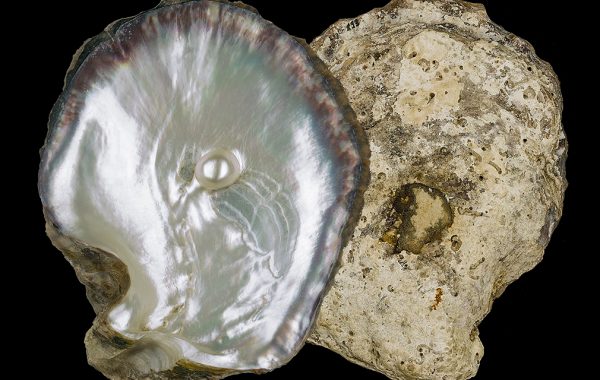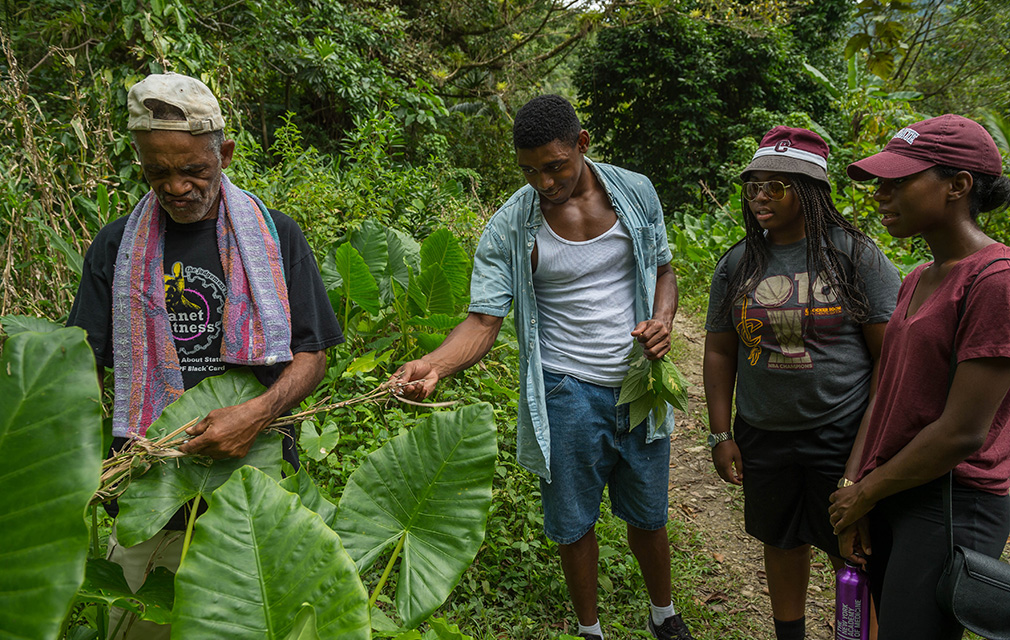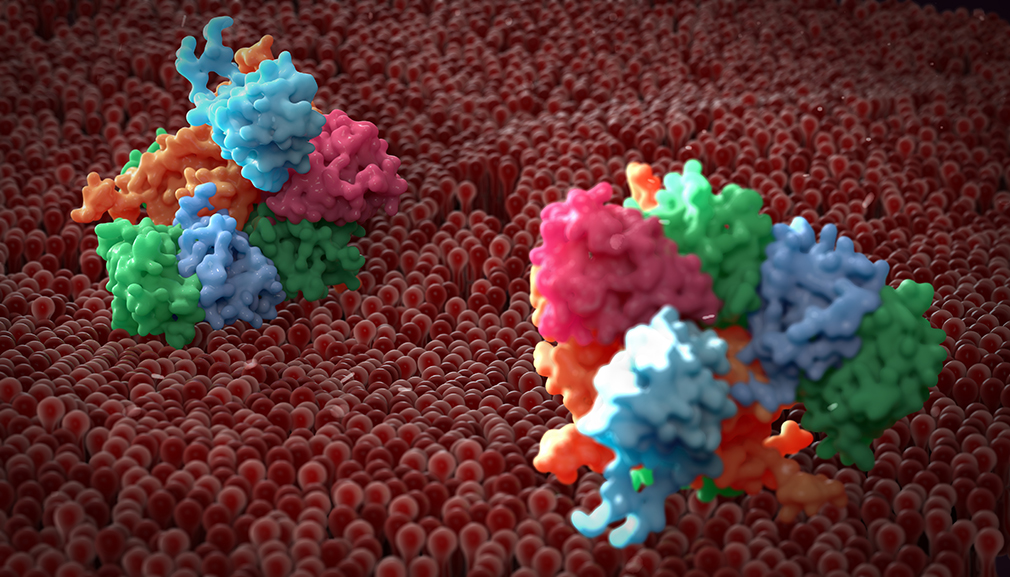For God and for truth: Colgate and the classics
The Doric columns of Memorial Chapel. The Latin inscription on James C. Colgate Hall. The university motto. Students and faculty encounter these vestiges of the classical world on campus almost daily. As the university’s bicentennial approaches, a spring seminar course and current exhibition highlight these classical traditions alongside the history of Colgate.
The exhibition Deo ac Veritati: Pursuing the Classics at Colgate is the culminating project of the course the Classics and the History of Colgate University, taught by Rebecca Miller Ammerman, classics professor. Located on the third floor of Case Library, the exhibition will remain open until next April.
As visitors ascend the third-floor staircase, they’re surrounded by transparencies that line the staircase’s glass panels on three sides. Mirroring the old within the new, the transparencies depict the interior of the university’s first library, which was located in James B. Colgate Hall until 1959.
“The transparencies are enlarged reproductions of the original glass plates captured by the photographer,” explained Michael Holobosky ’19, who developed the idea for the visual backbone of the exhibition. Holobosky is not only a student in Ammerman’s class, but he’s also employed at Colgate as a specialist in graphic design and digital print.
The exhibition also includes textbooks that belonged to Colgate’s early classics professors; portrait busts of Homer, Virgil, and 19th-century pastor and Colgate professor Walter Brooks; Greek homework assignments; and a side-by-side comparison of a classics student’s desk from then and now.
“I hope visitors realize that the ideas of the ancient Greeks and Romans were formative to many of our own,” Ammerman said. “There’s great value in cultures that make us reflect upon our own situation.”
Megan Delaney ’17 and Erica Hiddink ’17 have collaborated with Holobosky to make their findings available online to students and alumni worldwide at deoacveritati.colgate.edu.
“I want people to come away with a new appreciation for the classics; not just how it’s shaped Colgate’s identity but also how it’s shaped the American collegiate educational system,” Delaney said.
— Erin Burnett ’19
(Photo above: Historical classics course materials on display. Photo by Mark DiOrio)
Learning from bird brains
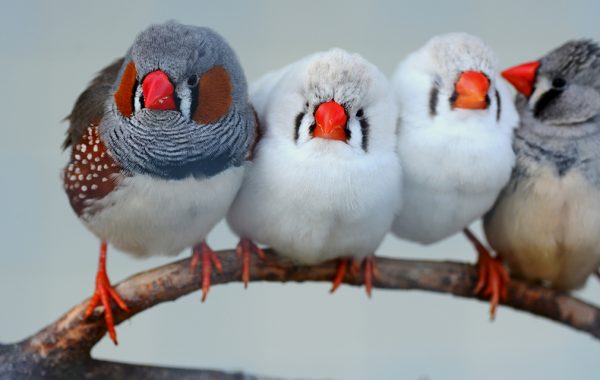
Colgate neuroscientist Wan-Chun Liu is using songbirds to understand better how the human brain learns to speak — and gain new insights into diseases that affect speech. Photo from iStock/pauly49
Professor Wan-Chun Liu’s lab is filled with the mellifluous tweets and squeaks of zebra finches, a small songbird native to Australia. The birds are highly social animals that teach their young to sing, much the same way that humans teach babies to talk.
“In both cases, [the young] have to interact with adults,” explained Liu, an assistant professor of neuroscience who joined Colgate last fall. “If they don’t have this early exposure, they cannot learn as well.”
Liu has been examining how the songbirds develop that vocalization in the brain and, in the process, trying to develop a better understanding of neurodegenerative disorders that affect speech in humans — diseases like Huntington’s, Parkinson’s, and Alzheimer’s. To further his research, Liu received a $155,000 grant this spring from the Picker Interdisciplinary Science Institute, which supports collaborations between Colgate faculty and outside researchers. The grant will allow him to use the relatively new technique of optogenetics — which gives scientists the power to manipulate genes using light — to study the effects of social learning on the brain.
In studies that he began at the Rockefeller Institute, Liu focused on the part of the brain called the basal ganglia, which is present in both songbirds and humans. During the critical period when the birds are learning their songs, several genes are highly expressed in this area, meaning that their DNA is actively involved in making proteins.
“It is also the first area to have damage from neurons dying when someone has Huntington’s disease,” Liu said.
By inserting a human gene for Huntington’s into zebra finch embryos, he has been able to create a strain of finches afflicted with the disease to understand how those genes affect brains. Relying on that new information, it may be possible to manipulate those genes, using therapies such as the genome-editing tool CRISPR to suppress the disease. “If we can use these types of genetic tools to silence the genes before they start to express and transcribe to RNA, maybe we can prevent the disorder from happening,” he said.
Recently, Liu has been looking at the connection between the basal ganglia and autism, a spectrum disorder that is associated not only with learning difficulties but also problems related to social interaction and communication. He is working on creating a new strain of transgenic zebra finches afflicted with autism, which he will then study using optogenetic techniques.
By inserting light-sensitive genes (opsins) into the finches, Liu and his collaborator, molecular-biologist Atsushi Miyanohara (UC San Diego), hope to make the birds start or stop singing by shining light on them. Working with neuroscientist Dmitriy Aronov (Columbia University), Liu will build a computer system to automatically track the interactions between different family members of finches, testing the effects of social interaction on the development of vocal learning and autism-like disorders.
“If you have autistic birds that have difficulty interacting with other birds and imitating song from the father tutor, what [changes] will happen in their brains?” he asked. “The overall goal is to better understand how genetics and the environment can affect vocal and other forms of social learning.”
— Michael Blanding
Applied mathematics named 55th Colgate major
Colgate’s applied-mathematics minor has graduated to become the university’s 55th major.
The consistent popularity of the minor and continued interest from students led to the creation of the full major this year, according to Daniel Schult, Charles G. Hetherington Professor of mathematics.
Applied mathematics is the use of mathematical theory and formulas to address real-world physical or computational problems.
“It doesn’t describe what kind of math we’re using as much as it describes the philosophy of how we’re using it,” Schult said. “In a regular mathematical setting, we’re working to prove whether something is true or not. With applied math, we’re saying that something has been proven — now what can we do with that?”
He also noted that there has been a recent trend of students creating their own applied-mathematics–themed majors through the natural sciences. That fact, combined with feedback from senior exit interviews, resulted in the development of the new major.
The major requires a senior capstone experience — a project-based class similar to thesis development — that relates back to the student’s focused area of application.
“We also decided there should be more computer interaction,” Schult said. “Most mathematicians are using computers in some way to do their mathematics now, so we’ve added a class at the sophomore level to introduce students to the mathematical computations that would normally be behind a website or in the guts of a software package. We’re trying to get to the nitty-gritty software-development level of programming. That will also allow us to use the computer in new ways in some of the higher-level classes.”
Jake Bensky ’19, of St. Louis, Mo., was leaning toward majoring in traditional mathematics, but he ultimately chose the applied-mathematics major because of his interest in statistics, data science, and the idea of putting complex computation to work.
“I am interested in how data and statistics can be used to solve problems and find insights,” Bensky said. “An applied-math major, along with my computer-science minor, can give me the background needed to excel in data science or any other role that uses data extensively.”
Professors shed light on pearl oysters
It’s rare to find an oyster with a pearl in it, but the iridescent material — called nacre — that coats the inside of oyster shells is actually made of the same material. Physics professors Rebecca Metzler and Enrique Galvez are leading a team of Colgate researchers to find out more about nacre’s structure, which is known for its strength and luster.
“There’s a lot of research into how that structure exists, but we wanted to probe it in a new way,” Metzler said. “Long-term understanding of biological materials, such as nacre, provides engineers with the ability to come up with new and improved ideas for material designs,” she explained.
In 2013, she and Galvez received a Picker Interdisciplinary Science Institute grant for this research, which uses imaging polarimetry — a new technique that involves measuring the polarization of light — to examine the formation of biominerals. The project brings together Metzler’s biophysical knowledge and Galvez’s understanding of physical optics.
With the help of visiting physics professor Joshua Jones and Anthony D’Addario ’18, Metzler and Galvez used a combination of imaging polarimetry and scanning electron microscopy to look more closely at the structure of the nacre.
They discovered that the myostracal layer — the part of the shell where the organism attaches — is composed of a structure of block-like crystals, making it very different from the nacre that surrounds it, which is made up of lines of tablets. They found that the tablets of the nacre that occur after the myostracal layer were much thicker and more uniform than those that occurred before the myostracal layer.
“We found that the [myostracal] layer appears to cause structural changes,” Metzler said. “We’re really intrigued by that. We aren’t sure yet if it’s a direct correlation or if it just happened that way.”
She and Galvez plan to continue their research with imaging polarimetry to find out more about this connection, and they’re also interested in using it to look at other biomaterials, such as chitin, a biomaterial that forms the exoskeleton of many insects.
Their current findings were published in the Royal Society Open Science online journal in February.
— Meredith Dowling ’17
Combining passions in fiction and in life
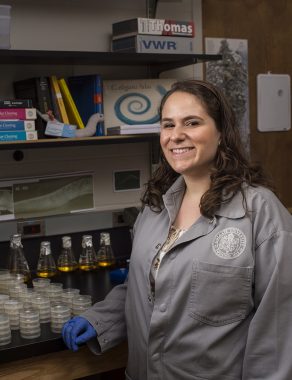
Allegra Padula ’19 received the 2017 Irvin David Yalom, M.D., Literary Award’s honorable mention. Photo by Mark DiOrio
In the short story “Humanistic Tendencies,” by Allegra Padula ’19, one of the main characters — Dr. Padula — decides to read her patient a poem. “Why not?” the character asks. “It is paper, ink, passion. It heals on a different level.”
The story received the 2017 Irvin David Yalom, M.D., Literary Award’s honorable mention. Although it is fictional, the story does contain elements of truth. The main character, after all, is named Dr. Padula, and the author Padula is a molecular-biology major who plans on becoming a doctor but also has a passion for poetry and is working toward an English minor.
“It’s easy to think that the creative process is lost in the scientific process, but for me, the most important thing is finding a balance between those and finding the creative parts of science,” she said.
Padula has always enjoyed writing, but after taking a poetry class last semester with Professor Peter Balakian, she started to think more seriously about it. “He taught me a lot about the power of creative writing to sustain people in hard times,” she said. “It inspired me to write my own poetry.”
Wanting to incorporate writing into her study of medicine, Padula searched online for kindred spirits and found the Pegasus Physician Writers group at Stanford. Although she’s unable to attend the California-based group’s meetings, Padula decided to enter their annual creative-writing contest. She is one of three winners, along with a Stanford University alumnus and a current Stanford student.
In “Humanistic Tendencies,” the character Dr. Padula learns about the importance of humanity in the practice of medicine through a long-term relationship with one of her patients. The scene where she reaches into the pocket of her white coat for a poem to read to her patient is a pivotal moment in which the two connect.
“Now more than ever, I think it’s important to take the time to value patients for who they are and listen to what they’re going through,” Padula said. “If doctors lose sight of that because they’re so busy — that’s the worst that can happen.”
— Meredith Dowling ’17
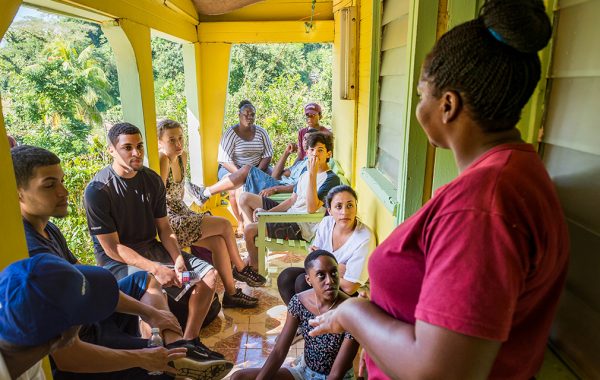 In Moore Town, Jamaica, study group participants learned firsthand about the Maroons and their culture. On the right, a resident tells students about life in Moore Town and prepares traditional food for them at her home. Pictured below, Colonel Wallace Sterling explains to students how his people use certain plants and roots for medicinal purposes. Professor Kezia Page led this Jamaica Study Group during the spring semester, taking the students on trips across the island to supplement their studies that began at Colgate and continued at the University of the West Indies at Mona.
In Moore Town, Jamaica, study group participants learned firsthand about the Maroons and their culture. On the right, a resident tells students about life in Moore Town and prepares traditional food for them at her home. Pictured below, Colonel Wallace Sterling explains to students how his people use certain plants and roots for medicinal purposes. Professor Kezia Page led this Jamaica Study Group during the spring semester, taking the students on trips across the island to supplement their studies that began at Colgate and continued at the University of the West Indies at Mona.
Fulbright in Brazil: identities and health
Kevin Iglesias ’17, of Silver Spring, Md., has been awarded a Fulbright research grant to travel to Brazil to study public health.
Iglesias, a peace and conflict studies major, will conduct research in the city of Salvador, Bahia, on the relationship between black/Afro-Brazilian LGBTQ identities and ethnic forms of traditional healing in Afro-matrix religions (AMR). While there exists separate research on Afro-Brazilian identities, LGBTQ identities, AMR, and public health, Iglesias’s project puts all of these into conversation with one another in a novel way.
He aims both to shed light on the lived realities of overlapping identities and also to understand the sense of empowerment that comes from the holistic-health attitudes found within AMR communities.
“Candomblé, which as a religion is wholly absorbed into everyday Brazilian life, has been a space where LGBTQ people are embraced,” Iglesias said. “For example, there are aspects of the religion that recognize that a male or female spirit can inhabit the body of an opposite gender. So being queer or being gay is accepted.”
As a junior, Iglesias spent a semester in Salvador, where he laid the foundation of this Fulbright project. During that semester, he conducted interviews with members of the LGBTQ community and people who provided public-health services to that community.
On campus, Iglesias is the promotional officer of the Latin American Student Organization and a member of the Spanish Language Debate Society; he’s also involved in theater and several dance groups.
Build it and they will heal
We may picture our cell membranes as smooth surfaces, but, actually, they are bristling with spiky structures called glycoproteins. “Some people call them the icing on the cake,” chemistry professor Ernie Nolen said. In healthy cells, these structures consist of a protein chain with a group of sugars attached on the end. Those sugars interact with molecules outside the cell. In some people with diseases such as cancer and muscular dystrophy, however, these glycoproteins break down and lose the all-important sugar on the end.
“If the sugars are not put on properly, the cell can migrate to other places, which in cancer is metastasis,” Nolen said. “In muscular dystrophy, if the sugar layer isn’t there, you don’t get adhesion to their support structures in the cellular matrix.” With a new, 3-year, $300,000 grant from the National Institutes of Health, Nolen is working to recreate structures like these artificially in order to detect diseases more accurately and potentially help to cure them.
Nolen has been working to create natural and synthetic molecules in his lab for more than 30 years. Oftentimes, these molecules are the keys to creating medicines that Mother Nature is ill-equipped to mass produce. The cancer drug Taxol, for example, originally came from compounds in the Pacific yew tree. But one 200-year-old, 40-foot tree only supplies 0.5 grams of the drug, when a typical treatment requires about 3 grams, Nolen said. “You’d have to harvest lots of trees for just one treatment.”
To make these complex molecules, Nolen first has to identify a useful compound and then come up with a construction plan, using reactions involving acids, bases, and other reagents to get them to adhere. “Most of my time I spend hammering one molecule onto another,” he said.
For the glycoprotein project, he is working to create a molecule just similar enough to those present in the body, but with a few crucial differences so the body recognizes it as foreign. He expects that the immune system will produce antibodies to the synthetic molecule, serving as a marker for the disease. “I’m trying to train the immune system to recognize certain structures so the antibodies that are formed can be a diagnostic of the early presence of a disease state,” he explained. That is crucial for diseases like muscular dystrophy and some forms of cancer, which are difficult to detect early on.
In addition, once the body starts producing those antibodies, then it will continue to produce them. The antibodies might aid in helping to kill the diseased cells as a way of treating the disease. “To some extent, your body is attacking cancer cells all the time,” Nolen said. “We want to amp up the immune system so that it gets angry and creates a better immune response.”
— Michael Blanding
Retirees granted emeritus status
With the end of the 2016–2017 school year, Colgate granted seven professors emeritus status:
Tony Aveni (astronomy, anthropology, and Native American studies), who has been at Colgate for 55 years, helped to develop the field of archaeoastronomy and is considered one of the founders of cultural astronomy. He has more than 300 research publications to his credit, led study groups to Central America and Peru, and received multiple awards for teaching.
Gloria Bien founded and shaped the Chinese language and literature curriculum and developed the Chinese major and minor programs. A 35-year veteran, she also served as department chair of the East Asian languages and literatures department for multiple terms. She played a central role in developing the China Study Group in Taiwan, Hong Kong, and Beijing.
A professor in the theater department for 22 years, Marjorie Kellogg has done set design for multiple productions on Broadway and off Broadway, as well as in theaters and opera houses around the country. She has designed more than 40 productions at Colgate. She is also the author of several novels and two produced plays.
Sociology and anthropology professor Rhonda Levine has been active in professional organizations and published numerous articles in a range of sociological journals. Since 1982, she has been on the advisory committees of many departments at Colgate, including Africana and Latin American studies, peace and conflict studies, and Jewish studies.
Jay Mandle is a leading scholar in African-American economic history, economic development, and the effects of globalization. Having been at Colgate since 1990, he has more recently turned his study to American democracy and equality. Mandle is the author of 14 books and more than 100 articles and book chapters.
In 2016, educational-studies professor Barbara Regenspan received the Professor of the Year award from the American Association of University Professors. At Colgate, she has been a valued coordinator of MAT and undergraduate social studies and English teacher certification programs.
Since joining Colgate in 1982, Roger Rowlett, the Gordon and Dorothy Kline Professor of chemistry, has established himself as a leader in undergraduate research. He has authored 17 primary research articles and three scholarly reviews and has brought more than $2 million to Colgate through external grants. Rowlett served as president of the Council on Undergraduate Research from 2015–2016.


